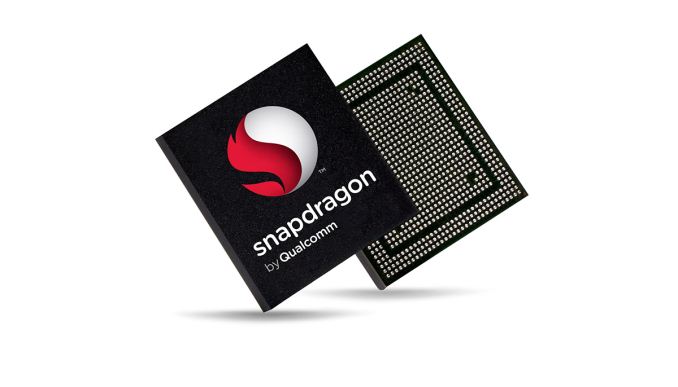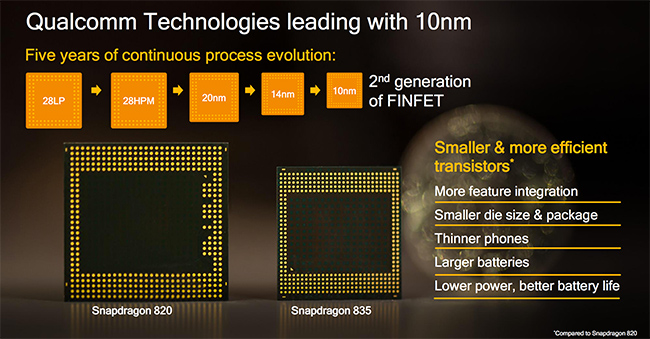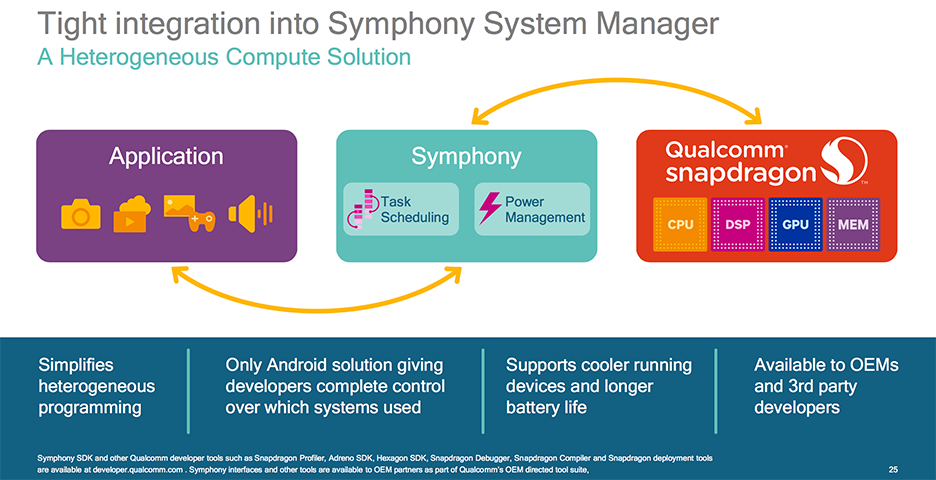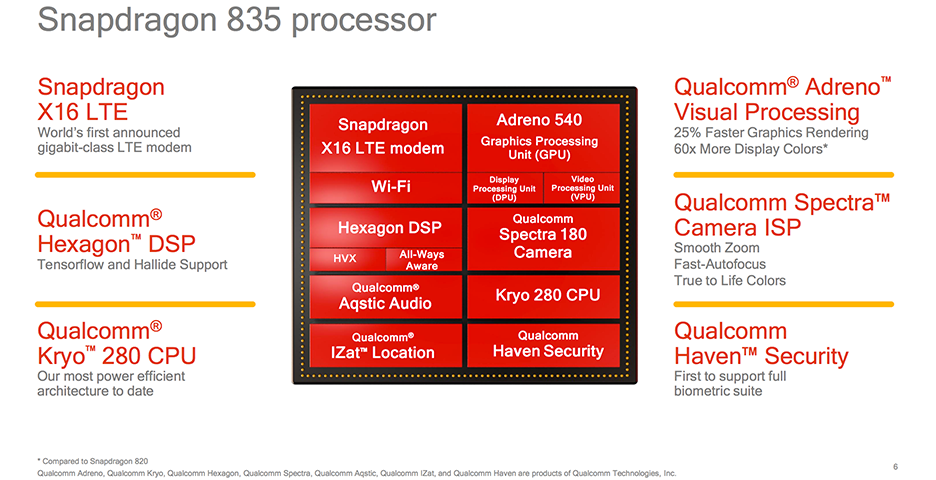Qualcomm Details Snapdragon 835: Kryo 280 CPU, Adreno 540 GPU, X16 LTE
by Matt Humrick on January 3, 2017 5:00 PM EST- Posted in
- Smartphones
- Snapdragon
- Qualcomm
- Adreno
- Mobile
- Snapdragon 835
- Kryo

Qualcomm previously revealed the name of its new high-end SoC, but today at CES 2017 it discussed the Snapdragon 835 in greater detail. Replacing the Snapdragon 820/821 as the pinnacle processor in its lineup, the 835 is the first commercial SoC to use Samsung’s 10nm "10LPE" FinFET manufacturing node. Qualcomm did not disclose die size, but it said the overall package size is 35% smaller than the Snapdragon 820 and contains more than 3 billion transistors. Samsung says its third-generation FinFET node “allows up to a 30% increase in area efficiency with 27% higher performance or up to 40% lower power consumption” relative to its first-generation 14nm 14LPE node at the same frequency, so Snapdragon 835’s process advantage over the 820, which uses Samsung’s second-generation 14LPP node, will be a bit less.
In addition to smartphones and tablets, Qualcomm sees the 835 powering IP cameras, VR and AR head-mounted displays (it has a reference HMD design available for partners and says several products are currently in development), and even new ultra-portable cellular PC devices with full Windows 10 support. This includes both Universal Windows Platform (UWP) apps, which run natively, and legacy x86 (32-bit) Win32 apps, which use software emulation. These new PC devices should also support any peripherals already supported by Windows 10 and eSIM support for cellular connectivity.
Qualcomm finds itself in a much different position today compared to one year ago when it launched the Snapdragon 820. Back then, it was on the hot seat after its previous flagship products, the Snapdragon 808 and 810, failed to meet expectations. Qualcomm’s implementation of ARM’s Cortex-A57 CPU core and TSMC’s last 20nm planar process were not a good combination, resulting in a generation of flagship phones that struggled to meet or exceed the performance of older models and exhibited higher than normal skin temperatures. The success of Snapdragon 820 would be crucial to regaining its partner’s trust and restoring its image with consumers.
The 820 was pivotal for another reason too: It introduced Qualcomm’s first custom 64-bit CPU core, Kryo. Creating a custom CPU (or GPU/DSP/ISP) is one way for SoC vendors to differentiate their products and establish themselves as innovators. Snapdragon 810’s use of stock ARM cores could be construed as a step backwards then after previous Snapdragon SoCs used Qualcomm’s custom Krait CPUs. Apple’s prior introduction of a custom 64-bit CPU, which caught everyone by surprise, only added fuel to the fire.
The Snapdragon 820 would go on to become a commercial success with many design wins. It powers the majority of flagship phones released over the past year, and while Kryo trails ARM’s A72 and Samsung’s M1 CPUs in IPC, it performs well enough to deliver a solid user experience.
With today’s launch of Snapdragon 835, Qualcomm looks to build on the 820’s success and its vision for the future: heterogeneous computing. By combining the unique abilities of each processor type—CPU, GPU, and DSP—Qualcomm hopes to bring new features and experiences, such as VR and machine learning, to mobile devices.
The 820 introduced several key features that form the foundation of this vision, which is why it’s so important to our discussion of the 835. Its Hexagon 680 DSP added single instruction, multiple data (SIMD) Hexagon Vector Extensions (HVX) specifically aimed at accelerating the aforementioned VR and machine learning workloads, along with more efficient processing of photography and computer vision tasks. The Adreno 530 GPU’s compute capabilities received a boost too, and the GPU and CPU gained the ability to snoop into the other’s cache using shared 64-bit virtual memory addressing, enabling better sharing of data. Qualcomm also introduced its Symphony System Manager alongside the 820 to provide task scheduling and power management for the various processor cores.
The Snapdragon 835 is more evolutionary than revolutionary by comparison. Every block within the new SoC receives an update, however, enabling new features and claims of higher performance and better battery life. With the backstory complete, it’s time to discuss these changes in more detail, starting with the biggest change of all: the CPU.













58 Comments
View All Comments
ddriver - Tuesday, January 3, 2017 - link
"Thinner phones" - please don't. I'd rather have double the battery life. We've long passed the point of reasonable thinness.Peskarik - Wednesday, January 4, 2017 - link
I know, right? The frigging things are so thin already one has to buy an ugly protective shell to be able to hold them properly!bug77 - Wednesday, January 4, 2017 - link
After all the videos of phones bending, videos of people cutting their fingers on phone's edges are only an evolutionary step :DWorldWithoutMadness - Wednesday, January 4, 2017 - link
evolutionary step... heh, more like devolution.If only people who bought the phones get to vote what features should be in the next generation of that phone, maybe we wouldn't be in this madness.
TheinsanegamerN - Wednesday, January 4, 2017 - link
you vote with your wallet.People keep buying the thinnest one, because your average consumer only cares about fashion accessories, and not having a useful tool.
Its about time we kickstarted our own brand of phone.
Omega215D - Wednesday, January 4, 2017 - link
I already did by buying the Moto Z Force over the Moto Z or iPhone 7. If I can't grip the phone comfortably without a case or attachment then it's a no go. It also needs to house a 3000mAH or larger battery.WorldWithoutMadness - Wednesday, January 4, 2017 - link
That's just like America voting all over again :D.Kickstart? Heh, if I'm not mistaken, everything failed to even make a dent.
For me, the moment google had to sell Motorola is the start of the downfall of a good trend (battery-performance-style-size) and motorola under lenovo just don't have that google chemistry anymore, looking at thinkpad series.... far from its legendary history.
Leosch - Thursday, January 5, 2017 - link
The problem is that you can't vote for individual features, only bundles of them in the form of individual products. Then the suits go and interpret the sales figures as "Oh, the thin one did well, we need to go thinner!", when in reality people perhaps bought the thin one because it has the best processor, screen and camera.prisonerX - Wednesday, January 4, 2017 - link
Yeah, unfortunatley the market disagrees with you and other whiners of your ilk.Go buy a phone with a removable battery and you can have as many multiples of battery life as you're willing to carry.
negusp - Wednesday, January 4, 2017 - link
How can it disagree with us when there aren't any mainstream flagship phones with removable batteries/large batteries?Besides, nobody wants to carry a bunch of replacement batteries. It's not that hard to throw an extra 2mm in and have a ~4000-5000 mAh battery.